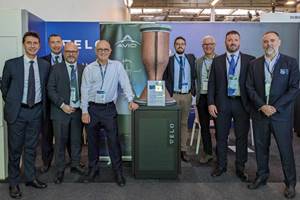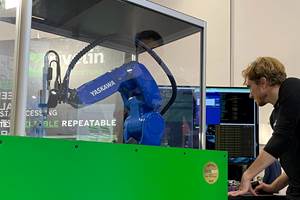Researchers Develop Resin for 3D Printing Implants for Cataracts, Other Eye Conditions
The ability to 3D print intraocular devices for treating cataracts and other eye conditions could significantly enhance eye care for patients by offering unparalleled levels of customization and design precision, potentially leading to better clinical outcomes.
University of East Anglia (UEA) researchers say they have made a significant breakthrough in ocular device technology with the introduction of a novel resin for 3D printing intraocular devices. This innovation has potential to enhance the manufacture of eye implants universally used in cataract and refractive surgeries.
An artificial intraocular lens (IOL) is primarily required for people with cataracts, a condition where the eye’s natural lens becomes cloudy, obscuring vision. The lens can also be also used to correct refractive errors such as myopia (nearsightedness), hyperopia (farsightedness) and presbyopia (when eyes gradually lose the ability to see things clearly up close, as a normal part of aging).
“For the first time, we have developed a resin that can be used to print ocular devices directly,” says Dr. Aram Saeed, lead study author and associate professor in Healthcare Technologies at UEA’s School of Pharmacy. “While still in the early stages, the ability to 3D print these lenses could significantly enhance eye care for patients by offering unprecedented levels of customization and design precision, potentially leading to better clinical outcomes.”
Historically, IOLs have been made from a variety of materials, including glass and silicone, although more recently the industry has significantly evolved to predominantly use acrylic materials.
Intraocular Lens Limitations
Currently, hydrophilic and hydrophobic acrylic are the most commonly used materials due to their excellent optical clarity, flexibility, biocompatibility with the body, and their stability and safety within the eye.
Current methods of making IOLs use lathing and molding techniques. While these methods offer the production of well-engineered and high-quality optical devices, they also come with inherent limitations, particularly in terms of design complexity and customization.
Transforming Ocular Device Technology
“3D printing could significantly enhance the production of ocular devices, not only improving speed and precision in manufacturing but also enabling greater complexity and customization in design,” Saeed says.
UEA’s proof-of-concept paper is the first in a series that will detail our developments in this area and set the stage for transforming eye care practices globally. “Our work combines material science with health care technology and requires extensive know-how in developing these types of ocular devices,” Saeed adds. “As we continue to publish our findings and share our advancements, we aim to be at the forefront of the industry, working with industrial partners and researchers worldwide to refine and enhance the technology."
Novel Resin Advantages
Although still in the early stages of development, this innovation could potentially have a variety of advantages:
-
Tailored Lenses: 3D printing could create lenses customized to each patient's eye shape and vision needs, potentially improving vision correction and comfort.
- Faster Production: Compared to traditional methods, 3D printing has the potential to enable quicker design, testing and manufacturing of lenses. This speed could reduce the time between diagnosis and surgery, providing faster care to patients.
- Complex Designs: 3D printing makes it possible to create intricate lens shapes that were previously difficult to manufacture. These designs could better address a wider range of vision problems.
- Cost Reduction: By using 3D printing, the production cost of custom or high-quality lenses may decrease, making them more affordable for more patients, particularly in economically disadvantaged regions. This could lead to better overall public health outcomes.
- Compatibility with Imaging: The researchers hope that combining 3D printing with advanced imaging technologies in the future could help produce lenses that optimally fit individual patients’ eyes, thereby reducing complications or the need for adjustments after surgery.
- Material Innovation: 3D printing enables the development of new materials with improved optical performance. This could result in lenses that not only correct vision but also enhance it.
The study found that the 3D printed lenses have good optical clarity, can be folded and implanted into a human capsular bag.
“If successful in further developments, this new technology could transform the industry by enabling portable manufacturing solutions, especially beneficial in remote and economically disadvantaged areas,” says Michael Wormstone, co-author and professor emeritus at UEA’s School of Biological Sciences. “It also has the potential to support the production of premium, customized lenses that could enhance surgical outcomes in more advanced health care settings."
Next Steps
The research team’s efforts have been recognized with a U.S. patent, assigned to UEA Enterprise Ltd., which is a business entity of the university focused on fostering innovation and commercializing research. The UEA researchers continue to work closely with industry partners to refine the technology. For example, further work has been underway to ensure the process works accurately on a larger scale and to increase the printing resolution to improve the dimensional accuracy. It is hoped that clinical trials could start in the next few years.
Saeed and Wormstone have a strong partnership with the ophthalmology department at Norwich and Norfolk University Hospital (NNUH), which brings valuable clinical insights and visionary approaches to their work. Both the UEA and hospital are members of the Norwich Research Park.
“This innovation has the potential to enable the production of lenses that match patient specifications in design and optical performance,” says Anas Injarie, a consultant ophthalmologist at NNUH with more than 20 years of experience. “For premium markets, it represents an exciting possibility to provide tailored treatments that could enhance patient satisfaction and surgical success.”
The research was funded by the UEA through the Innovation Development Fund and Proof-Of-Concept grants; the Humane Research Trust; and the Engineering and Physical Sciences Research Council (EPSRC). Further funding was provided by the UEA’s Impact Acceleration Account (IAA) funding from the Medical Research Council (MRC).
The ‘Stereolithographic Rapid Prototyping of Clear, Foldable, Nonrefractive Intraocular Lens Designs: A Proof-of-Concept Study’ is published in the journal Current Eye Research.
Related Content
Avio Utilizes Velo3D Metal Printers for Developing Propulsion Systems
The Italian space propulsion innovator is installing the printers in its Colleferro, Italy, headquarters to produce mission-critical parts for its family of rocket engines.
Read More3D Printed Capo for Banjo Made With Binder Jetting not MIM: The Cool Parts Show #74
New market, no mold tooling needed: Additive manufacturing via binder jetting enables a maker of guitar capos to expand to serve banjo players as well.
Read MoreThe Robot Craftsman: Force Sensing and Vision Help Realize Automated AM Postprocessing (Includes Video)
Automated production via additive manufacturing will need automated postprocessing. This UK startup is equipping robots with the capabilities needed for critical, fine-detail finishing of metal 3D printed parts.
Read MoreThe Connector Conundrum: 3D Printed Mold Tooling’s Role in Innovation
ReelView Fishing faced an electronics obstacle in the development of its new technology for underwater video. Additive manufacturing for moldmaking allowed for the speed necessary to iterate to a solution. How inventors and invention will benefit from new ways of obtaining production-ready tooling.
Read MoreRead Next
Crushable Lattices: The Lightweight Structures That Will Protect an Interplanetary Payload
NASA uses laser powder bed fusion plus chemical etching to create the lattice forms engineered to keep Mars rocks safe during a crash landing on Earth.
Read MoreAlquist 3D Looks Toward a Carbon-Sequestering Future with 3D Printed Infrastructure
The Colorado startup aims to reduce the carbon footprint of new buildings, homes and city infrastructure with robotic 3D printing and a specialized geopolymer material.
Read MorePostprocessing Steps and Costs for Metal 3D Printing
When your metal part is done 3D printing, you just pull it out of the machine and start using it, right? Not exactly.
Read More





















